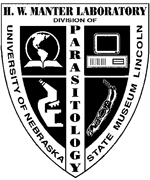Parasitology, Harold W. Manter Laboratory of

Harold W. Manter Laboratory of Parasitology: Library Materials
Document Type
Article
Date of this Version
1924
Citation
American Museum Novitates (July 24, 1924) 126, 10 pages.
Contributions from the Biological Laboratory, New York University.
Abstract
Occasional examinations of rats for animal parasites have been carried on for over a hundred years. Later, knowledge of the importance of rats as reservoirs of infection and as agents in the transfer of parasitic diseases has led to the regular and careful examination of large numbers in various parts of the world. Among the more recent publications dealing with the parasites of rats may be mentioned Shipley (1908), Moll (1917), Chandler (1921), Balfour (1922), Baylis (1922), Stevenson (1922), Hegner (1923), and Lavier (1924). Notwithstanding the many investigations, only a single trematode parasite has previously been discovered and concerning it so little is known that its identity is questioned. The first record, that of Dujardin (1845), contains a brief description of the parasite which he named Distorna spicutator. Six specimens were found in the small intestine of Rattus norvegicus taken at Rennes, France, but they were not sexually mature and the author suggested that they might be identical with D. trigonocephalum Rudolphi, a species previously reported from the badger, polecat, hedgehog, weasel, and martin.
The form described by Rudolphi has been studied by several investigators and is a well-established species. Cobbold (1860) transferred both D. trigonocephatum and D. spiculator to the genus Echinostoma. I). Irigonocephalum had been shown to be synonymous with P. metis Schrank, and Lühe (1909) erected the genus Isthmiophora to contain it. Referring to the trematode from the rat, Lühe says it has been found only twice and he ineluded it as Echinostoma spiculator sp. inq.; very similar if not identical with Isthmiophora melis. Odhner (1910) discredited the genus Isthmiophora and transferred the species E. trigonocephalum to the genus Euparyphium Dietz.
During the past year the junior author has been engaged in the parasitological examination of rats from New York City. On November 1, 1923, he discovered in mucosal scrapings from the jejunum of one specimen of R. norvegicus a large number of very small trematodes. This rat, together with sixteen others, was caught near the Clason Point dump on the water front.


Comments
Public domain material.